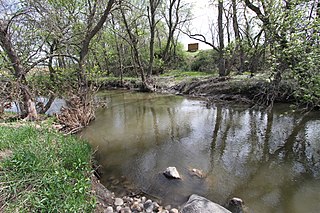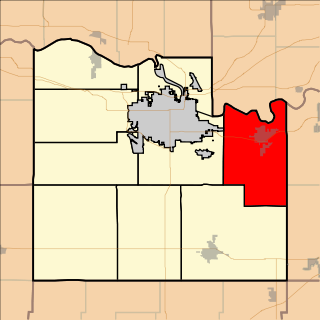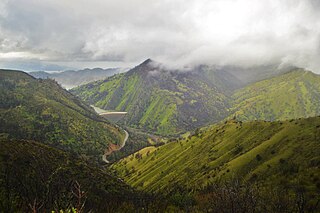This article needs additional citations for verification .(February 2018) (Learn how and when to remove this template message) |
Jacobs Creek is a tributary of the Cottonwood River in the Flint Hills of south central Kansas in the United States. [1]

A tributary or affluent is a stream or river that flows into a larger stream or main stem river or a lake. A tributary does not flow directly into a sea or ocean. Tributaries and the main stem river drain the surrounding drainage basin of its surface water and groundwater, leading the water out into an ocean.

Cottonwood River is one of the principal tributaries of the Neosho River in central Kansas of the United States.

The Flint Hills, historically known as Bluestem Pastures or Blue Stem Hills, are a region in eastern Kansas and north-central Oklahoma named for the abundant residual flint eroded from the bedrock that lies near or at the surface. It consists of a band of hills stretching from Kansas to Oklahoma, extending from Marshall and Washington Counties in the north to Cowley County, Kansas and Kay and Osage Counties in Oklahoma in the south, to Geary and Shawnee Counties west to east. Oklahomans generally refer to the same geologic formation as the Osage Hills or "the Osage."
The headwaters are just south of the Kansas Turnpike and the mouth is at its confluence with the Cottonwood River between Emporia and Saffordville in Kansas. The terrain of the watershed is hilly and used primarily as rangeland. The drainage area upstream of the Kansas Turnpike is only about a few square miles. Jacobs Creek crosses the slightly elevated embankment of the turnpike through culverts.
The Kansas Turnpike is a 236-mile-long (380 km), freeway-standard toll road that lies entirely within the U.S. state of Kansas. It runs in a general southwest–northeast direction from the Oklahoma border to Kansas City. It passes through several major Kansas cities, including Wichita, Topeka, and Lawrence. The turnpike is owned and maintained by the Kansas Turnpike Authority (KTA), which is headquartered in Wichita.

Emporia is a city in and the county seat of Lyon County, Kansas, United States. As of the 2010 census, the city population was 24,916. Emporia lies between Topeka and Wichita at the intersection of U.S. Route 50 with Interstates 335 and 35 on the Kansas Turnpike. Emporia is also a college town, home to Emporia State University and Flint Hills Technical College.

Saffordville is an unincorporated community in Chase County, Kansas, United States.
The Jacobs Creek Flood occurred in 2003.












